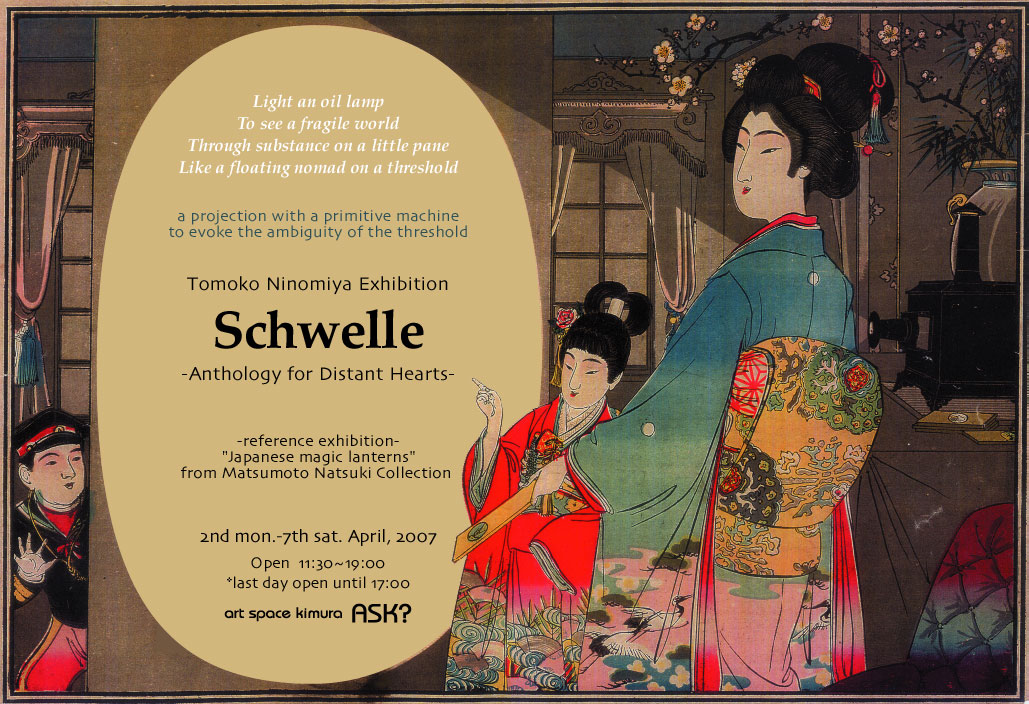
image:ad-leaflet for a restaurant during the Meiji era
Introduction
A phantom of moonlight between the visible and invisible
---though not seen clearly, a faint moon-shadow shimmers on virtual-real-film at the threshold---
Natsuki Matsumoto
- Iconologist
| Tomoko Ninomiya's work "Schwelle" consists of a series of images, like phantoms, painted on panes of glass and projected on a screen with an old magic lantern. Her body of work gives us a glimpse of the interval between real and unreal, and, a hint of the shimmering threshold as seen through dim and fragile flame. It also presents a phenomenon: through a process of permeation of pigment and substance on the glasses, the image is scattered over the threshold and re-emerges from 'over there' onto the screen. These subtle images which are invisible to us until our eyes adjust to the darkness, represent the birth of something that neither exists nor non-exists. Perhaps they are shadows of those beings who dwell in 'Mundus Imaginalis (Imaginary world)' which Henry Corbin (1903-1978) discussed as a state of the Islamic theosophical ('ishraq) sphere, a semi-real-world, between the real and idea. The miniature lantern used for "Schwelle" was a toy popular with families and children in the Meiji period. The 'Lanterna Magica (magic lantern)' was introduced to Japan in the middle of the 18th century, and was developed by the Japanese into wooden lanterns, called 'FURO', which made the performances more dynamic by using plural projectors with complex glass slides (shikake-taneita) at a same time. These performances, shadow plays, were called 'Utsushi-e' and became very popular at the end of the Edo era(1598-1867) through the Meiji era(1868-1912) so that several permanent Utsushi-e theatres were built. When the western magic lantern was re-introduced at the beginning of the Meiji era, it was recognized as one of the useful tools for illumination by the Restoration government. It came to be well known through the lantern makers' tour called 'Educational Magic Lantern Show'. After 1880, cheaper tin magic lanterns and glass slides, Tane-ita, were produced and people could enjoy them at home. At that time houses had no power supplies and oil lamps were used for projection. Yet, for the people using dim lanterns or candles, the impression of emerging pictures from darkness was even more vivid than we, using electricity, can imagine. The vividness of the images was caused, not by the quantity of light for culutral enlightenment, but by an imaginary world that was invoked by emerging illusions at obscure corners of their accustomed houses. Which Rampo Edogawa(Japanese author, 1894-1965) , beginning with childhood explorations of light phenomenon and continued a lifelong fascination with optical instruments and magic lanterns revealed well in his motto, “The living world is a dream, night dreams are exactly my realities.” |
Tomoko Ninomiya exhibition
Schwelle vol.3
-Anthology for Distant Hearts-
-reference exhibition-
"Japanese magic lanterns"from Matsumoto Natsuki Collection
2 mon.-7 sat. April, 2007
close